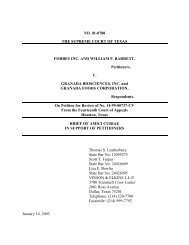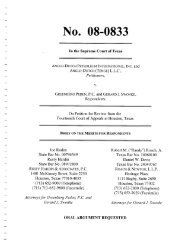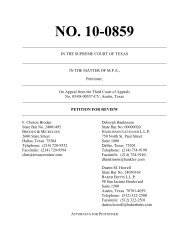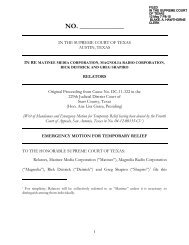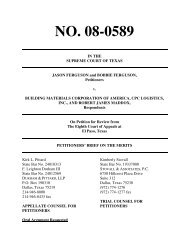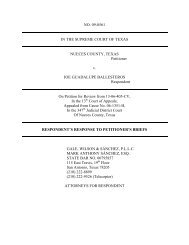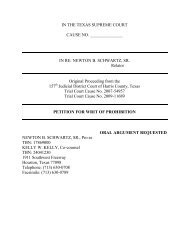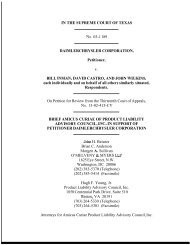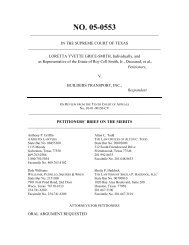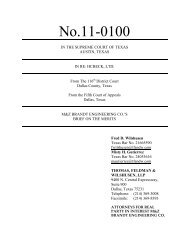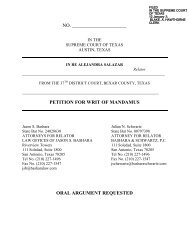Petitioner's Brief on the Merits - Supreme Court of Texas
Petitioner's Brief on the Merits - Supreme Court of Texas
Petitioner's Brief on the Merits - Supreme Court of Texas
You also want an ePaper? Increase the reach of your titles
YUMPU automatically turns print PDFs into web optimized ePapers that Google loves.
o<strong>the</strong>rwise provided by <strong>the</strong> plan. 26 U.S.C.A. § 414(p)(1)(A); 29 U.S.C.A. § 1056(d)(3).<br />
Plan administrators do not undertake a substantive review <strong>of</strong> <strong>the</strong> QDROs and are, in fact,<br />
required to approve QDROs that meet <strong>the</strong>se simple requirements and do not violate <strong>the</strong><br />
parameters <strong>of</strong> <strong>the</strong> pensi<strong>on</strong> plan itself. 29 U.S.C.A. § 1056(d)(3). The <strong>Texas</strong> Legislature has<br />
in turn amended <strong>the</strong> Family Code to provide for QDRO proceedings after divorce. Act <strong>of</strong><br />
May 27, 1995, 74 th Leg., R.S., ch. 1026, 1995 Tex. Gen. Laws 5106 (codified at TEX. FAM.<br />
CODE §§ 9.101-.105). Thus, it is increasingly important that <strong>the</strong> courts develop an accurate<br />
understanding <strong>of</strong> <strong>the</strong>se pensi<strong>on</strong> benefits and how to divide <strong>the</strong>m appropriately within <strong>the</strong><br />
c<strong>on</strong>fines <strong>of</strong> c<strong>on</strong>stituti<strong>on</strong>ally guaranteed marital property rights.<br />
B. Defined c<strong>on</strong>tributi<strong>on</strong> and defined benefit plans are fundamentally<br />
different.<br />
Employee retirement plans fall into two main categories: defined c<strong>on</strong>tributi<strong>on</strong> and<br />
defined benefit plans. 8<br />
As this case illustrates, courts and practiti<strong>on</strong>ers frequently fail to<br />
appreciate <strong>the</strong> differences between <strong>the</strong> two plans when approving, drafting, and interpreting<br />
divorce decrees and QDROs. The differences are critical because <strong>the</strong> method <strong>of</strong> proper<br />
apporti<strong>on</strong>ment and valuati<strong>on</strong> <strong>of</strong> a given plan differs depending <strong>on</strong> <strong>the</strong> type <strong>of</strong> plan and facts<br />
<strong>of</strong> <strong>the</strong> case.<br />
1. Defined c<strong>on</strong>tributi<strong>on</strong> plans<br />
Defined c<strong>on</strong>tributi<strong>on</strong> plans, sometimes known as “individual account” plans, are<br />
composed <strong>of</strong> c<strong>on</strong>tributi<strong>on</strong>s from <strong>the</strong> employer or employee and have no pre-set formula for<br />
determining benefits. Instead, benefits are determined by <strong>the</strong> amount <strong>of</strong> c<strong>on</strong>tributi<strong>on</strong>s plus<br />
6




